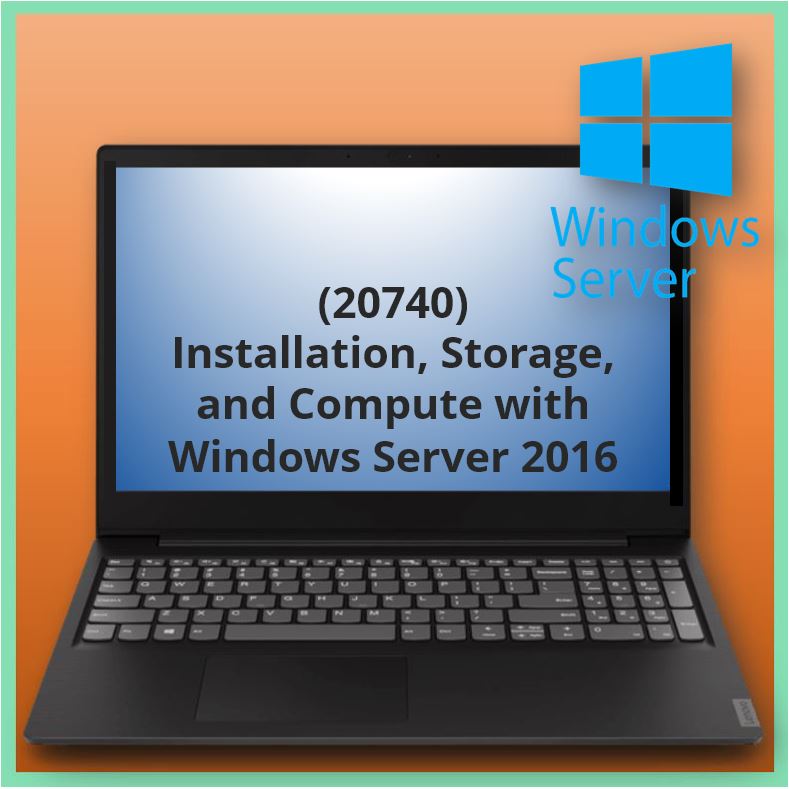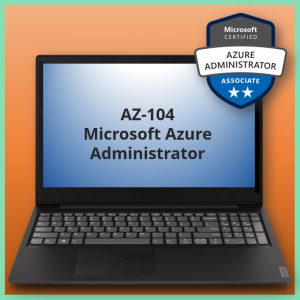Aangeboden leervormen
Installation, Storage, and Compute with Windows Server 2016 (20740)
Course Description
This course is designed primarily for IT professionals who have some experience with Windows Server. It is designed for professionals who will be responsible for managing storage and compute by using Windows Server 2016, and who need to understand the scenarios, requirements, and storage and compute options that are available and applicable to Windows Server 2016.
At Course Completion
After completing this course, students will be able to:
• Prepare and install Nano Server, a Server Core installation, and plan a server upgrade and migration strategy.
• Describe the various storage options, including partition table formats, basic and dynamic disks, file systems, virtual hard disks, and drive hardware, and explain how to manage disks and volumes.
• Describe enterprise storage solutions, and select the appropriate solution for a given situation.
• Implement and manage Storage Spaces and Data Deduplication.
• Install and configure Microsoft Hyper-V.
• Deploy, configure, and manage Windows and Hyper-V containers.
• Describe the high availability and disaster recovery technologies in Windows Server 2016.
• Plan, create, and manage a failover cluster.
• Implement failover clustering for Hyper-V virtual machines.
• Configure a Network Load Balancing (NLB) cluster, and plan for an NLB implementation.
• Create and manage deployment images.
• Manage, monitor, and maintain virtual machine installations.
Voor wie
This course is intended for IT professionals who have some experiencing working with Windows Server, and who are looking for a single five-day course that covers storage and compute technologies in Windows Server 2016. This course will help them update their knowledge and skills related to storage and compute for Windows Server 2016.
Candidates suitable for this course would be:
• Windows Server administrators who are relatively new to Windows Server administration and related technologies, and who want to learn more about the storage and compute features in Windows Server 2016.
• IT professionals with general IT knowledge, who are looking to gain knowledge about Windows Server, especially around storage and compute technologies in Windows Server 2016.
The secondary audience for this course are IT professionals looking to take the Microsoft 70-740 certification exam, Installation, Storage and Compute with Windows Server 2016.
Programma
Voor het programma van e-learning >>> KLIK HIER <<<
Module 1: Installing, upgrading, and migrating servers and workloads
This module explains how to prepare and install Nano Server and Server Core. This module also explains how to upgrade and migrate server roles and workloads. Finally, this module explains how to choose an activation model based on your environment characteristics.
Lessons
• Introducing Windows Server 2016
• Preparing and installing Nano Server and Server Core
• Preparing for upgrades and migrations
• Migrating server roles and workloads
• Windows Server activation models
Lab : Installing and configuring Nano Server
• Implementing Nano Server
• Completing post-installation tasks on the Nano Server
• Performing remote management
After completing this module, students will be able to:
• Choose the appropriate version of the Windows Server operating system, and describe the installation options and new features of Windows Server 2016.
• Prepare and install Nano Server and Server Core.
• Consider whether an upgrade or migration is the best approach, and use tools to help determine upgrade or migration suitability.
• Migrate server roles and workloads within a domain and across domains or forests.
• Choose an activation model based on your environment characteristics.
Module 2: Configuring local storage
This module explains how to manage disks and volumes in Windows Server 2016.
Lessons
• Managing disks in Windows Server 2016
• Managing volumes in Windows Server 2016
Lab : Managing disks and volumes in Windows Server 2016
• Creating and Managing virtual hard disks by using Windows PowerShell
• Converting virtual hard disks from .vhd to .vhdx
• Resizing a volume
After completing this module, students will be able to:
• Manage disks in Windows Server 2016.
• Manage volumes in Windows Server 2016.
Module 3: Implementing enterprise storage solutions
This module describes the direct-attached storage (DAS), network-attached storage (NAS), and storage area networks (SANs). It also helps you understand Microsoft Internet Storage Name Service (iSNS) Server, data center bridging, and Multipath I/O (MPIO). Additionally, this module also compares Fibre Channel, Internet Small Computer System Interface (iSCSI), and Fibre Channel Over Ethernet (FCoE), and describes how to configure sharing in Windows Server 2016. Lessons
• Overview of direct-attached storage, network-attached storage, and storage area networks
• Comparing Fibre Channel, iSCSI, and FCoE
• Understanding iSNS, data centre bridging, and MPIO
• Configuring sharing in Windows Server 2016
Lab : Planning and configuring storage technologies and components
• Planning storage requirements
• Configuring iSCSI storage
• Configuring and managing the share infrastructure
After completing this module, students will be able to:
• Describe DAS, NAS, and SANs, and the usage scenarios for each topology.
• Compare Fibre Channel, FCoE, an iSCSI target and initiator.Describe iSNS, MPIO, data center bridging, and Windows Storage Server 2016 (two versions—Workgroup and Standard).
• Configure server message block (SMB) and network file system (NFS) shares by using Server Manager and Windows PowerShell.
Module 4: Implementing Storage Spaces and Data Deduplication
This module explains how to implement and manage Storage Spaces. This module also explains how to implement Data Deduplication.
Lessons
• Implementing Storage Spaces
• Managing Storage Spaces
• Implementing Data Deduplication
Lab : Implementing Storage Spaces
• Creating a storage space
• Enabling and configuring storage tiering
Lab : Implementing Data Deduplication
• Installing Data Deduplication
• Configuring Data Deduplication
After completing this module, students will be able to:
• Implement Storage Spaces as an enterprise storage solution.
• Manage Storage Spaces by using Server Manager and Windows PowerShell.
• Implement Data Deduplication.
Module 5: Installing and configuring Hyper-V and virtual machines
This module provides an overview of Hyper-V. This module also explains how to configure, manage, and install Hyper-V.
Lessons
• Overview of Hyper-V
• Installing Hyper-V
• Configuring storage on Hyper-V host servers
• Configuring networking on Hyper-V host servers
• Configuring Hyper-V virtual machines
• Managing Hyper-V virtual machines
Lab : Installing and configuring Hyper-V
• Installing the Hyper-V server role
• Configuring Hyper-V settings
• Creating and configuring a virtual machine
• Managing a virtual machine by using PowerShell Direct
After completing this module, students will be able to:
• Describe Hyper-V and virtualization.
• Prepare to install the Hyper-V role.
• Configure storage on Hyper-V host servers.
• Configure networking on Hyper-V host servers.
• Configure Hyper-V virtual machines.
• Move virtual machines from one host to another host, using PowerShell Direct to manage a virtual machine, and manage miscellaneous virtual machine settings.
Module 6: Deploying and managing Windows Server and Hyper-V containers
This module provides and overview of containers in Windows Server 2016. It also explains how to deploy, install, configure, and manage containers in Windows Server 2016.Lessons
• Overview of containers in Windows Server 2016
• Deploying Windows Server and Hyper-V containers
• Installing, configuring, and managing containers
Lab : Installing and configuring containers
• Installing and configuring Windows Server containers by using Windows PowerShell
• Installing and configuring Windows Server containers by using Docker
After completing this module, students will be able to:
• Explain the purpose of Windows Server and Hyper-V containers.
• Deploy and manage Windows Server and Hyper-V containers.
• Install, configure, and manage containers.
Module 7: Overview of high availability and disaster recovery
This module provides an overview of high availability, business continuity, and disaster recovery. It further explains how to plan high availability and disaster recovery solutions. Additionally, in this module you will know how to back up and restore the Windows Server 2016 operating system and data by using Windows Server Backup. Finally, you will learn about Windows Server 2016 high availability with failover clustering.
Lessons
• Defining levels of availability
• Planning high availability and disaster recovery solutions with Hyper-V virtual machines
• Backing up and restoring the Windows Server 2016 operating system and data by using Windows Server B
• High availability with failover clustering in Windows Server 2016
Lab : Planning and implementing a high availability and disaster recovery solution
• Determining the appropriate high availability and disaster recovery solution
• Implementing storage migration
• Implementing Hyper-V Replica
After completing this module, students will be able to:
• Describe high availability, business continuity, and disaster recovery.
• Plan for high availability and disaster recovery solutions with Hyper-V virtual machines.
• Back up and restore Hyper-V hosts, virtual machines, Active Directory Domain Services (AD DS), and file and web servers by using Windows Server Backup.
• Describe Windows Server 2016 high availability with failover clustering.
Module 8: Implementing and managing failover clustering
This module explains how to plan, create, configure, maintain, and troubleshoot a failover cluster. This module also explains how to implement site high availability with stretch clustering.
Lessons
• Planning a failover cluster
• Creating and configuring a new failover cluster
• Maintaining a failover cluster
• Troubleshooting a failover cluster
• Implementing site high availability with stretch clustering
Lab : Implementing a failover cluster
• Creating a failover cluster
• Verifying quorum settings and adding a node
Lab : Managing a failover cluster
• Evicting a node and verifying quorum settings
• Changing the quorum from Disk Witness to File Share Witness, and defining node voting
• Adding and removing disks from the cluster
After completing this module, students will be able to:
• Describe the requirements and infrastructure considerations for a failover cluster.
• Create and configure a new failover cluster.
• Monitor and maintain failover clusters.
• Troubleshoot failover clusters by using various tools such as Performance Monitor, Event Viewer, and Windows PowerShell.
• Configure and implement a stretch cluster.
Module 9: Implementing failover clustering for Hyper-V virtual machines
This module describes integrating Hyper-V virtual machines in a clustered environment. It also explains how to implement and maintain Hyper-V virtual machines on failover clusters. Additionally, this module also explains how to configure network health protection.
Lessons
• Overview of integrating Hyper-V in Windows Server 2016 with failover clustering
• Implementing and maintaining Hyper-V virtual machines on failover clusters
• Key features for virtual machines in a clustered environment
Lab : Implementing failover clustering with Hyper-V
• Configuring a failover cluster for Hyper-V
• Configuring a highly available virtual machine
After completing this module, students will be able to:
• Explain the integration of Hyper-V in Windows Server 2016 with failover clustering.
• Implement and maintain Hyper-V virtual machines on failover clusters.
• Describe and configure network health protection.
Module 10: Implementing Network Load Balancing
This module provides an overview of NLB clusters. It also explains how to plan and configure an NLB cluster implementation.Lessons
• Overview of NLB clusters
• Configuring an NLB cluster
• Planning an NLB implementation
Lab : Implementing an NLB cluster
• Implementing an NLB cluster
• Configuring and managing the NLB cluster
• Validating high availability for the NLB cluster
After completing this module, students will be able to:
• Describe NLB and how it works.
• Configure an NLB cluster.
• Describe the considerations for implementing NLB.
Module 11: Creating and managing deployment images
This module provides an introduction to deployment images. It also explains how to create and manage deployment images by using the Microsoft Deployment Toolkit (MDT). Additionally, it explains how to evaluate an organization’s requirements for server virtualization.
Lessons
• Introduction to deployment images
• Creating and managing deployment images by using MDT
• Virtual machine environments for different workloads
Lab : Using MDT to deploy Windows Server 2016
• Installing and configuring MDT
• Creating and deploying an image
After completing this module, students will be able to:
• Explain the purpose of deployment images and the tools that you use to deploy and maintain them.
• Implement and manage deployment images by using MDT.
• Evaluate their organization’s requirements for server virtualization.
Module 12: Managing, monitoring, and maintaining virtual machine installations
This module provides an overview on WSUS and explains the deployment options. It explains how to update management process with WSUS and also how to use Performance Monitor. Additionally, this module also provides an overview of PowerShell Desired State Configuration (DSC) and Windows Server 2016 monitoring tools. Finally, this module describes how to use Performance Monitor and monitor Event Logs.
Lessons
• WSUS overview and deployment options
• Update management process with WSUS
• Overview of PowerShell DSC
• Overview of Windows Server 2016 monitoring tools
• Using Performance Monitor
• Monitoring Event Logs
Lab : Implementing WSUS and deploying updates
• Implementing WSUS
• Configuring update settings
• Approving and deploying an update by using WSUS
Lab : Monitoring and troubleshooting Windows Server 2016
• Establishing a performance baseline
• Identifying the source of a performance problem
• Viewing and configuring centralized event logs
After completing this module, students will be able to:
• Describe the purpose of Windows Server Update Services (WSUS) and the requirements to implement WSUS.
• Manage the update process with WSUS.
• Describe the purpose and benefits of PowerShell DSC.
• Describe the monitoring tools available in Windows Server 2016.
• Describe how to use Performance Monitor.
• Describe how to manage event logs.
Voorkennis
Before attending this course, students must have:
• A basic understanding of networking fundamentals.
• An awareness and understanding of security best practices.
• An understanding of basic AD DS concepts.
• Basic knowledge of server hardware.
• Experience supporting and configuring Windows client operating systems such as Windows 8 or Windows 10.
Additionally, students would benefit from having some previous Windows Server operating system experience, such as experience as a Windows Server systems administrator.
Examen
Microsoft examen 70-740 Installation, Storage, and Compute with Windows Server 2016
Duur training
Klassikaal: 4 dagen
Blended learning: 3 dagen
Open leercentrum: 5 dagen
E-learning: 90 dagen











